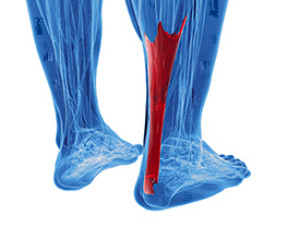 The Achilles tendon, while the largest and thickest tendon in the body, is prone to being injured just like any body part. Tendinopathy, the breakdown of the tendon, generally occurs from overuse—especially from athletic activities. In some cases, the tendon can even rupture completely. While overuse directly causes the injury, there are other factors that increase the risk. These factors include bending the foot backwards, or dorsiflexion, weak calf muscles, and pronation. Compared to other muscle recoveries, tendons take longer to heal and can even take up to a year to fully recover. While anti-inflammatory medication may bring relief, it will not heal the injury. Ultimately, the best thing to do for an Achilles tendon injury is to see a podiatrist. Podiatrists offer the best treatment options and recovery programs for such injuries, and they can help patients heal properly so they can get back in the game.
The Achilles tendon, while the largest and thickest tendon in the body, is prone to being injured just like any body part. Tendinopathy, the breakdown of the tendon, generally occurs from overuse—especially from athletic activities. In some cases, the tendon can even rupture completely. While overuse directly causes the injury, there are other factors that increase the risk. These factors include bending the foot backwards, or dorsiflexion, weak calf muscles, and pronation. Compared to other muscle recoveries, tendons take longer to heal and can even take up to a year to fully recover. While anti-inflammatory medication may bring relief, it will not heal the injury. Ultimately, the best thing to do for an Achilles tendon injury is to see a podiatrist. Podiatrists offer the best treatment options and recovery programs for such injuries, and they can help patients heal properly so they can get back in the game.
Achilles tendon injuries need immediate attention to avoid future complications. If you have any concerns, contact Dr. Sharon Pletcher of Pennsylvania. Our doctor can provide the care you need to keep you pain-free and on your feet.
What Is the Achilles Tendon?
The Achilles tendon is a tendon that connects the lower leg muscles and calf to the heel of the foot. It is the strongest tendon in the human body and is essential for making movement possible. Because this tendon is such an integral part of the body, any injuries to it can create immense difficulties and should immediately be presented to a doctor.
What Are the symptoms of an Achilles Tendon Injury?
There are various types of injuries that can affect the Achilles tendon. The two most common injuries are Achilles tendinitis and ruptures of the tendon.
Achilles Tendinitis Symptoms
- Inflammation
- Dull to severe pain
- Increased blood flow to the tendon
- Thickening of the tendon
Rupture Symptoms
- Extreme pain and swelling in the foot
- Total immobility
Treatment and Prevention
Achilles tendon injuries are diagnosed by a thorough physical evaluation, which can include an MRI. Treatment involves rest, physical therapy, and in some cases, surgery. However, various preventative measures can be taken to avoid these injuries, such as:
- Thorough stretching of the tendon before and after exercise
- Strengthening exercises like calf raises, squats, leg curls, leg extensions, leg raises, lunges, and leg presses
If you have any questions please feel free to contact our office located in State College, PA. We offer the newest diagnostic tools and technology to treat your foot and ankle needs.
Read more about What are Achilles Tendon Injuries



